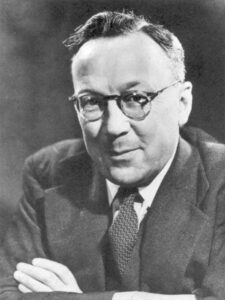Sir Robert Watson-Watt

Sir Robert Watson-Watt was born on the 13th of April 1892 in the Angus town of Brechin; he was a descendant of the celebrated engineer and inventor of the steam engine James Watt In his youth, Watson-Watt excelled in his studies and was awarded ‘Dux’ of Brechin High School. He went on to study for a Bachelor of Science in engineering at University College, Dundee, now the University of Dundee but then part of the University of St Andrews. After graduating, he went to work for the Meteorological Office in England where he researched the detection of thunderstorms using radio waves. His aim for this research was to provide pilots with advance warning about such thunderstorms and so prevent them from being struck by lightning. Watson-Watt climbed the ranks of the Meteorological Office and in 1934 was named head of its radio Research Department.
In the 1930’s and the lead up to World War II, fear of air attack grew. In response, the Air Ministry asked Watson-Watt to investigate the possibility of creating a ‘death-ray’ which could heat up German warplanes and trigger their explosive payloads. Along with his assistant, A.F. Wilkins, he quickly realised that would not be possible. Instead, they focused their efforts on aircraft detection.
In February 1935, a pilot was instructed to fly from Farnborough to the Midlands and back. This flight path took the pilot’s bomber past the BBC’s short-wave transmitter near Daventry, where nearby Watson-Watt and Arnold Wilkins were cramped in a van. They attentively observed a cathode ray tube to see if they could detect the aircraft, and sure enough when the bomber passed about eight miles away it appeared as a growing and then fading blip on the instrument. They could detect the aircraft due to radio waves from the BBC’s transmitter reflecting off the bomber and being received by the cathode ray tube; modern day radar still works in the same way. At this achievement, Watson-Watt is purported to have turned to Wilkins and said, “Britain is an Island once more”.
Soon after, funding poured into the detection of aircraft via radio waves, with the detection range quickly expanding to up to 120 miles. Watson-Watt and Arnold Wilkins weren’t the only ones researching the application of radio technology in this way, with the United States also keen on its development. It is the US term RADAR (Radio Detection and Ranging) which is commonly used today.
By the onset of war, a vast network of radar stations had been constructed. This network, referred to as ‘Chain Home’, was championed by Watson-Watt and formed an unbroken screen along the British coast. The Battle of Britain proved radar to be an invaluable asset. The RAF was outnumbered 3-1 by the Luftwaffe (German air force), however radar levelled the playing field; Britain could scramble fighters to intercept German bomber formations and their fighter escorts long before they reached their targets. Without radar, Britain may not have withstood the constant bombardment designed to wear it down and destroy its air force.
Watson-Watt was appointed a Fellow of the Royal Society in 1941 and knighted in 1942. He spent many of his post-war years in Canada and the US, and in 1958 released his own account of the development of radar in ‘Three Steps to Victory’. However, while living in Canada in 1956, Watson-Watt received ‘a taste of his own medicine’. His technology had recently been employed in radar guns to catch speeding drivers, and a police officer pulled him over for that very offence. He is alleged to have said afterwards ‘My God, if I’d known what they were going to do with it, I’d have never have invented it!’
Watson-Watt moved back to Scotland in the 1960’s, settling in Pitlochry. He died on 5th December 1973, in Inverness. Despite his enormous achievement, until 2014 the only monument to his work was a small plaque located in Daventry where he and Arnold Wilkins made the first detection of an aircraft using radio waves. In 2014, however, The Princess Royal unveiled a statue of him in his hometown of Brechin showing him with a Spitfire in one hand and a radar tower in the other.
